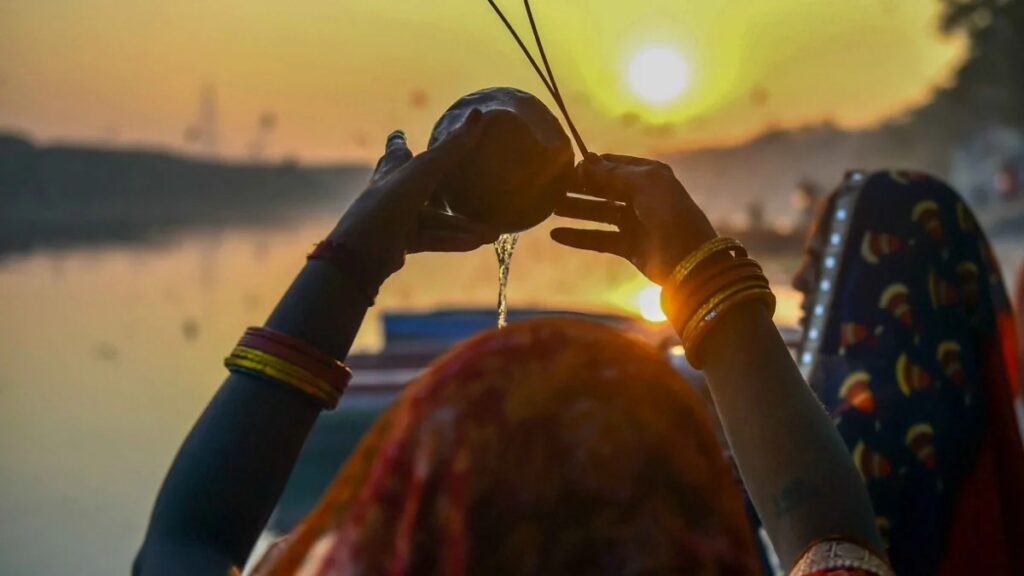Chhath Puja 2024 Sunset Time (Surya Arghya) In UP, Bihar, Patna, Ranchi, New Delhi And Noida: Today, on the third day of Chhath Puja, there is a tradition of offering Arghya to the Sun God during sunset. Find out the sunset time according to different cities.

The grand festival of faith, Chhath, is being celebrated with great enthusiasm across the country. Today is a very special day. The third day of Chhath is called Badi Chhath. It is believed that with the offering of Kharnā prasad (the food offering), a 36-hour strict waterless fast begins, which ends on the fourth day with the offering of Arghya to the Sun God during dawn. Chhath Puja is considered one of the most rigorous vows. On the third day of Chhath, devotees perform a ritual to offer Arghya to the setting Sun in the evening. Let’s find out the exact time for the evening Arghya in your city…
Chhath Maiya’s Aarti
It is important to note that Chhath Mahaparv is primarily celebrated in Bihar. In addition, it is also observed with great fervor in Jharkhand, Uttar Pradesh, Delhi, and other regions, both within India and abroad. On the third day, after offering Arghya to the setting Sun, devotees offer Arghya to the rising Sun on the fourth day. After this, the fasting devotees break their fast by consuming the prasad and then distribute it to others, while praying to Sun God and Chhathi Maiya for health, prosperity, and happiness.
Here are the sunset timings for today, November 9, 2024, in major cities:
- New Delhi: Sunset at 5:26 PM
- Noida: Sunset at 5:26 PM
- Patna (Bihar): Sunset at 5:12 PM
- Ranchi (Jharkhand): Sunset at 5:14 PM
- Lucknow (Uttar Pradesh): Sunset at 5:18 PM
- Varanasi (Uttar Pradesh): Sunset at 5:18 PM
How to Offer Arghya to the Setting Sun
On the third day of Chhath Puja, devotees offer Arghya to the setting Sun. During this ritual, the devotee stands in waist-deep water and worships the Sun God. To offer Arghya, take a pitcher (lota) and fill it with water, a few drops of raw milk, red sandalwood powder, flowers, rice (akshat), and kush grass. Then, slowly pour the water from the pitcher as an offering to the Sun. While doing this, chant the Sun Mantras. Afterward, the devotee performs the worship using the items placed in the doura (a basket) and soop (a flat winnowing basket).
Beliefs behind why Chhath is celebrated
Chhath Puja is a four-day elaborate celebration in honour of the Sun. It involves a long fast without water, and making offerings to Usha and Pratyusha — the light of the rising and the setting Sun respectively — while standing in a water body. The prominent rituals begin from the sixth day (shashthi) of the Kartik shukla paksha, which means the waxing-moon fortnight of the month of Kartik.
Several beliefs are prevalent about why Chhath is observed. Some believe that it is a carryover from the time that man worshipped nature. Others trace its origins in the great epics, the Ramayana and the Mahabharata.
The Rig Veda mentions elaborate rituals to worship the sun.
After Lord Ram and Goddess Sita returned victorious to Ayodhya from Lanka, they are said to have observed a fast and conducted a yagna for the Sun god.
In the Mahabharata, when the Pandavas were in exile, some sages visited them. Draupadi, realising she had nothing to offer them, went to sage Dhaumya for help. He advised her to observe a fast and pray to the Sun, and eventually, all her prayers were answered. In the same epic, Karna also organised an elaborate ceremony in honour of Surya (the Sun), his father.
“Both Sita and Draupadi conducted their Sun worship on the Kartik shukla paksha shashthi. Worshipping the Sun on shashthi is considered specially auspicious,” said Dr Ramesh Kumar Upadhyay, president of the Bhartiya Jyotish Aadhyatm parishad in Jamshedpur.